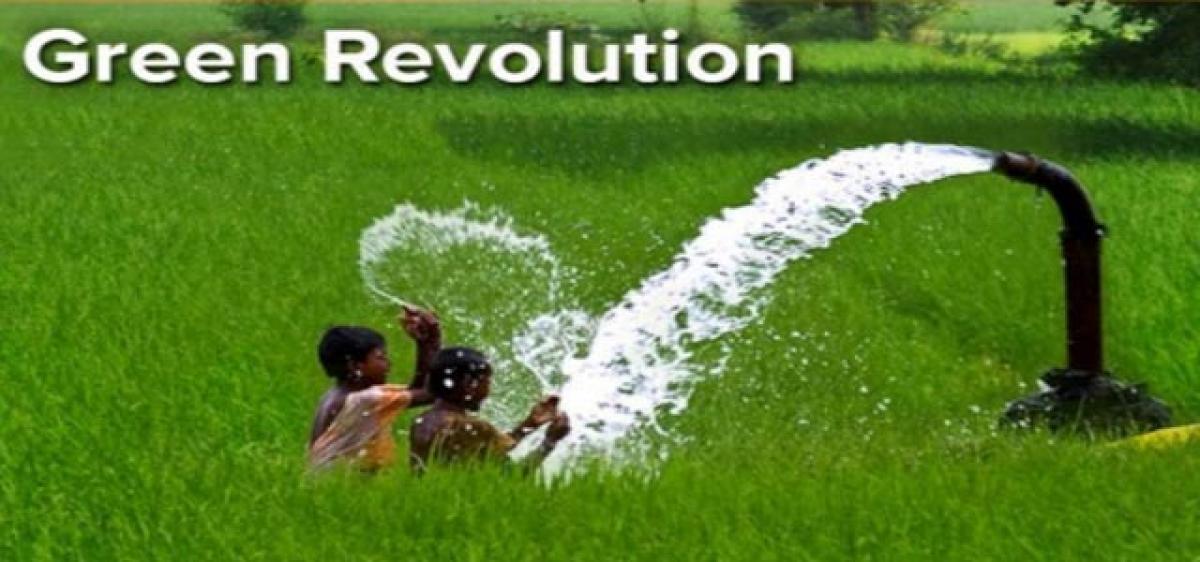For a workable Green Revolution

India is an agrarian country providing employment directly or indirectly to around 60 percent of the rural population. Even with heavy input subsidies, loan waivers schemes and minimum support prices, among other things, farmers’ suicides are rampant while agricultural growth remains sluggish.
India is an agrarian country providing employment directly or indirectly to around 60 percent of the rural population. Even with heavy input subsidies, loan waivers schemes and minimum support prices, among other things, farmers’ suicides are rampant while agricultural growth remains sluggish.
Ironically, it is the middlemen who are reaping dividends. Why it is so and what is the remedy?
The traditional agriculture was a soil and climate driven farming system that encompassed animal husbandry and provided socio-economic, food and nutrient security. Those were the ‘golden days’ in the history of farming. It was an environment-friendly system and was highly successful and sustainable. No pollution, no worry about seeds and fertilizer adulteration as they used good grain as seed and compost of farmyard manure and green manure as fertilizer.
The 1960s saw “profit-driven western chemical inputs tailored-mono crop technology” that came to be known as Green Revolution Technology [GRT], increased the production substantially in terms of quantity but failed to achieve the quality of traditional agriculture. Unfortunately, our scientists get paid from public money but serve western multinational companies. It is all like the present demonetization scheme wherein government and people lost through new notes printing, importing Chinese Machines, using US Cards and losing livelihood.
On an average, around 65 percent of cultivated area is at the mercy of “rain gods”. The remaining 35 percent of the area under irrigation presents high year to year fluctuations. The present rulers are diversifying lakhs of acres for non-agriculture activities; yet our land statistics are not changing.
When GRT was introduced nobody knew that this would create an environmental catastrophe – air, water [particularly non-point source], soil and food pollution. Even the Nobel Prize awarding organization was not aware of this while conferring it to Norman Borlaug.
The traditional technology was evolved over hundreds of years’ experience of farmers and whereas the GRT was evolved over few years research farm experience with large yield gap between on farm and research station. To make it viable entered government’s input subsidy, a huge component. Around one-third of the fertilizer finds its way in to black market. In accordance with my proposal, the then UPA government initiated to pay cash subsidy directly to farmers with Aadhaar link, instead of retailers or industry. However, this subsidy does not include organic fertilizers. This needs to be addressed.
In India Bt-cotton, the Genetically Modified [GM] Seed is in use since 2002-03. The productivity has been stagnant for the past five years – in the case of GRT it is stagnated since 1984-85. With the no crop rotation and changes in climate, in the five Bt-Cotton states, the farmers’ suicides are rampant with the high investments. The 2nd Green Revolution must be farming system. To achieve this goal, governments must create a mechanism to collect traditional inventions of progressive farmers and integrate them into traditional technology to achieve the 2nd Green Revolution that safeguards the environment and provide food safety, bio-safety, food and nutrient security.
To achieve sustainable agriculture, therefore, the governments must change the policy. It must include low input costs, pollution-free quality food technology such as organic inputs under cooperative farming setup. This not only brings down the cost of production but also reduces man-hours spent on procuring basic inputs by individual farmers, improves the utilization of natural resources and thus helps to reach sustainable agriculture. Better water management plays a crucial role – diversifying through less water intensive crops under micro irrigation systems. We need crop rotation and intercropping system to reduce the risk under cash crops.
However, the success depends upon: better post-harvesting technologies including sufficient storage facilities, export facilities, transport facilities, food processing industries, better education and health care facilities, which might reduce the migration to urban centers. (The writer is a former Chief Technical Advisor of WMO/UN)
By Dr S Jeevananda Reddy















